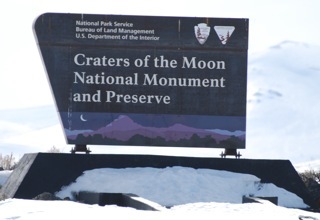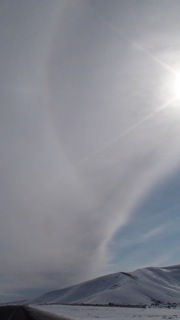 Craters of the Moon: "A Geologic Prelude to Yellowstone"Last week I explored Craters of the Moon National Monument on my drive from Yellowstone to Yosemite. Although snow covered most of the area, it could not banish the sublime strangeness of a volcanically birthed landscape.
Craters of the Moon: "A Geologic Prelude to Yellowstone"Last week I explored Craters of the Moon National Monument on my drive from Yellowstone to Yosemite. Although snow covered most of the area, it could not banish the sublime strangeness of a volcanically birthed landscape.
When I stopped in the park visitor center and inquired about the geology of the region, I was truly lucky to find the park geologist, Douglass Owen, behind the desk. After learning that I had just come from Yellowstone, he described Craters as a geologic precursor to the first national park.
 HaloAs the park guidebook notes: “Craters of the Moon represents what Yellowstone’s landscape will resemble in the future, and both areas can supplement your insight into what happens when the Earth’s unimaginable inner forces erupt to its surface.”
HaloAs the park guidebook notes: “Craters of the Moon represents what Yellowstone’s landscape will resemble in the future, and both areas can supplement your insight into what happens when the Earth’s unimaginable inner forces erupt to its surface.”
Even given the harsh ecological conditions of a lava dominated-land, life abounds in the area—hardy flora and fauna that have adapted to a rocky, dry, wind-swept existence. Small blossoms of cinquefoil may peek out of rocky crevices, while intrepid lichen paints the rocks in reds, yellows, and greens. One of my favorite animals, the pika, has also managed to set up household in the lava fields; at 6,000 feet above sea level, Craters of the Moon is one of the lowest elevations where pika can be found.
During my visit to the park, the sun left its signature on an outstretched cloud: a partial halo.

